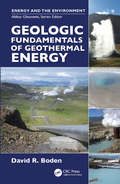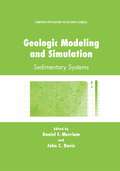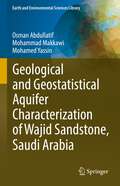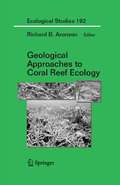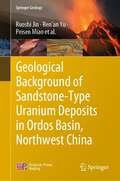- Table View
- List View
Geologic and Mine Modelling Using Techbase and Lynx
by Martin SmithThis text provides a process oriented discussion of the theory, methodology and philosophy of geologic and mine modelling using two commercial software packages: Techbase, a leader for mineral exploration and modelling bedded deposits; and Lynx, for modelling geology.
Geologic Carbon Sequestration: Understanding Reservoir Behavior
by V. Vishal T. N. SinghThis exclusive compilation written by eminent experts from more than ten countries, outlines the processes and methods for geologic sequestration in different sinks. It discusses and highlights the details of individual storage types, including recent advances in the science and technology of carbon storage. The topic is of immense interest to geoscientists, reservoir engineers, environmentalists and researchers from the scientific and industrial communities working on the methodologies for carbon dioxide storage.Increasing concentrations of anthropogenic carbon dioxide in the atmosphere are often held responsible for the rising temperature of the globe. Geologic sequestration prevents atmospheric release of the waste greenhouse gases by storing them underground for geologically significant periods of time. The book addresses the need for an understanding of carbon reservoir characteristics and behavior. Other book volumes on carbon capture, utilization and storage (CCUS) attempt to cover the entire process of CCUS, but the topic of geologic sequestration is not discussed in detail. This book focuses on the recent trends and up-to-date information on different storage rock types, ranging from deep saline aquifers to coal to basaltic formations.
Geologic Fundamentals of Geothermal Energy
by David R. BodenGeothermal energy stands out because it can be used as a baseload resource. This book, unlike others, examines the geology related to geothermal applications. Geology dictates (a) how geothermal resources can be found, (b) the nature of the geothermal resource (such as liquid- or vapor-dominated) and (c) how the resource might be developed ultimately (such as flash or binary geothermal plants). The compilation and distillation of geological elements of geothermal systems into a single reference fills a notable gap.
Geologic Fundamentals of Geothermal Energy
by David R. BodenGeothermal energy stands out because it can be used as a baseload resource. This book, unlike others, examines the geology related to geothermal applications. Geology dictates (a) how geothermal resources can be found, (b) the nature of the geothermal resource (such as liquid- or vapor-dominated) and (c) how the resource might be developed ultimately (such as flash or binary geothermal plants). The compilation and distillation of geological elements of geothermal systems into a single reference fills a notable gap.
Geologic Modeling and Mapping (Computer Applications in the Earth Sciences)
by Andrea Förster Daniel F. MerriamThis volume is a compendium of papers on the subject, as noted in the book title, of modeling and mapping. They were presented at the 25th Anniversary meeting of the International Association for Mathematical Geology (IAMG) at Praha (Prague), Czech Republic in October of 1993. The Association, founded at the International Geological Congress (IGC) in Prague in 1968, returned to its origins for its Silver Anniversary celebration. All in all 146 papers by 276 authors were offered for the 165 attendees at the 3-day meeting convened in the Hotel Krystal. It was a time for remembrance and for future prognostication. The selected papers in Geologic Modeling and Mapping comprise a broad range of powerful techniques used nowadays in the earth sciences. Modeling stands for reconstruction of geological features, such as subsurface structure, in space and time, as well as for simulation of geological processes both providing scenarios of geologic events and how these events might have occurred. Mapping stands for spatial analysis of data, a topic that always has been an extremely important part of the earth sciences. Because both modeling and mapping are used widely in conjunction, the book title should reflect the close relation of the subjects rather than a division. Here, we bring together a collection of papers that hopefully contribute to the growing amount of knowledge on these techniques.
Geologic Modeling and Simulation: Sedimentary Systems (Computer Applications in the Earth Sciences)
by Daniel F. Merriam John C. DavisModeling and simulation were introduced to the earth sciences about four decades ago. Modeling has proven its worth and now it is an accepted procedure for analyzing and solving geological problems. The papers in this collection are focused on modeling sediment deposition and sedimentary sequences and have a decidedly practical flavor. Some of the leading simulation packages, such as CORRELATOR, SEDFLUX, SEDpak, SEDSIM, STRATA, and STRATSIM are applied to problems in hydrocarbon exploration, oil production, groundwater development, coal-bed appraisal, geothermics, and environmental diagnosis. All of these subjects fall under the broad heading of sedimentary basin analysis. The fifteen papers in this volume are written by internationally recognized experts from academia and industry. The contributions represent the status of geologic modeling and simulation at the start of the 21st century, and will give the reader an insight into current research problems and their possible solutions.
Geologic Structures of the Arctic Basin
by Alexey Piskarev Victor Poselov Valery KaminskyThis book contains the most complete description of the geologic and geophysical data of the structure of Arctic Basin including structures of the earth’s crust, crustal and acoustic basement, and sedimentary cover. The book includes information about extracted and studied cores and samples; observed, processed and interpreted data on geophysical anomalies and different conceptions, and a hypotheses of the origin of the modern Arctic Basin structures. Progress in solving the problems of the Arctic Basin geology is presented in the chapters and include contributions from leading field experts.
Geological and Biological Effects of Impact Events (Impact Studies)
by ChristianKoeberl EricBuffetautThis book is the first volume of a new interdisciplinary series on "Impact Studies". The volumes of this series aim to include all aspects of research related to impact cratering - geology, geophysics, paleontology, geochemistry, mineralogy, petrology, planetolgy, etc. Future volumes will include monographs, field guides, conference proceedings, etc. All contributions in this book were peer-reviewed to ensure high scientific quality. The thirteen papers in the present volume result from a workshop of the European Science Foundation (ESF) IMPACT programme ("Response of the Earth System to Impact Processes"). This programme is an interdisciplinary effort aimed at understanding impact processes and their effects on the Earth System, including environmental, biological, and geological changes, and consequences for the biodiversity of ecosystems. The goals of the programme, and details about our activities, can be found on the web at . The IMPACT programme has currently 15 member nations from allover Europe. The activities of the programme range from workshops to specific topics regarding impact cratering, short courses on impact stratigraphy, shock metamorphism, etc. , mobility grants for students and young researchers, development of teaching aids, and publications. The third IMPACT workshop was held in Quillan, in the foothills of the French Pyrenees, in September 1999.
Geological and Geo-Environmental Processes on Earth (Springer Natural Hazards)
by Arun Kumar Shandilya Vinod Kumar Singh Suresh Chandra Bhatt Chandra Shekhar DubeyThis edited volume dedicated to late Prof. P.S. Saklani addresses the multidisciplinary themes pertaining to role of tectonism and magmatism in Crustal Evolution and global distribution of metallic and non metallic mineral deposits. It gives valuable information on geodynamic evolution, structural, petrological, isotopic, metamorphic, geochemical and geochronological attributes of continental and oceanic crust and is challenging reassessments of the existing paradigms. It addresses the implication of magmatism, metallogeny and application of geochronological ages (U-Pb SHRIMP age, Lu-Hf isotopic system; detrital zircons). This book also advocates the role of tectonics in contamination of ground water, and control on drainage pattern and geothermal systems. It explores the vulnerability of earth towards natural hazards viz. earthquakes, floods, cyclones, tsunami, volcanism, cyclones and drought. This volume throws light on the applications of remote sensing, GIS (Geographical Information System) and SRTM data for evaluation of the morphometric and morphotectonic parameters and exploring the susceptibility of river basins toward erosion and flood. It will be beneficial to graduate and post-graduate students as well as professionals and researchers.
Geological and Geostatistical Aquifer Characterization of Wajid Sandstone, Saudi Arabia (Earth and Environmental Sciences Library)
by Osman Abdullatif Mohammad Makkawi Mohamed YassinThe book summarizes research work on the Wajid Sandstone, which provides integrated field and laboratory data to enable a detailed description of this unit including a facies analysis, porosity data, as well as permeability data to establish aquifer models. Detailed facies analysis at outcrop scale are supported by vertical and lateral sedimentological sections, facies and environmental analysis and supplemented by detailed laboratory petrographical and petrophysical data. The analysis and interpretation of the outcrop analog models include the reconstruction of the stratigraphic architecture at outcrop scale. Moreover, the results were described statistically, analyzed and eventually establish an outcrop-based aquifer model analogue. The book benefits undergraduate, graduate and researchers working on applied sedimentological studies, hydrogeology, statistical and geostatistical analysis and modeling.
Geological and Mud Logging in Drilling Control: Catalogue of Typical Cases
by Ecole Nationale Supérieure du Pétrole et des MoteursGeological Approaches to Coral Reef Ecology (Ecological Studies #192)
by Richard B. AronsonThis book provides a unique perspective on the destruction - both natural and human-caused - of coral reef ecosystems. Reconstructing the ecological history of coral reefs, the authors evaluate whether recent dramatic changes are novel events or part of a long-term trend or cycle. The text combines principles of geophysics, paleontology, and marine sciences with real-time observation, examining the interacting causes of change: hurricane damage, predators, disease, rising sea-level, nutrient loading, global warming and ocean acidification. Predictions about the future of coral reefs inspire strategies for restoration and management of ecosystems. Useful for students and professionals in ecology and marine biology, including environmental managers.
Geological Atlas of Africa: With Notes on Stratigraphy, Tectonics, Economic Geology, Geohazards and Geosites of Each Country
by Thomas SchlüterHere is the new edition of the first attempt to summarize the geology of Africa by presenting it in an atlas and to synthesize the stratigraphy, tectonics, economic geology, geohazards and geosites of each country and territory of the continent. Furthermore, the digitized geological maps are correlated and harmonized according to the current stratigraphic timetable. The atlas aims to contribute to capacity building in African Earth Sciences and to aid the initiation of research and enable the achievement of economic opportunities by providing a database of basic geological background information.
Geological Atlas of Africa: With Notes on Stratigraphy, Tectonics, Economic Geology, Geohazards, Geosites and Geoscientific Education of Each Country
by Thomas SchlüterT is atlas is intended primarily for anybody who is in-some background for the arrangement of how the terested in basic geology of Africa. Its originality lies atlas was done. T e second chapter is devoted to the in the fact that the regional geology of each African history of geological mapping in Africa, necessary nation or territory is reviewed country-wise by maps for a fuller appreciation of why this work in Africa is and text, a view normally not presented in textbooks worth doing. Chapter 3 provides an executive s- of regional geology. It is my belief, that there has long mary on the stratigraphy and tectonics of Africa as a been a need in universities and geological surveys, whole, i. e. in the context of no political boundaries. both in Africa and in the developed world, for sum- T e main part of the atlas lies in Chapter 4, where in marizing geological maps and an accompanying basic alphabetical order each African country or territory text utilising the enormous fund of knowledge that is presented by a digitized geological overview map has been accumulated since the beginning of geologi- and an accompanying text on its respective strat- th cal research in Africa in the mid-19 century. I hope raphy, tectonics, economic geology, geohazards and that, in part, the present atlas may satisfy this need. geosites. A short list of relevant references is also a- ed.
Geological Background of Sandstone-Type Uranium Deposits in Ordos Basin, Northwest China (Springer Geology)
by Ruoshi Jin Ren’an Yu Peisen MiaoThis book introduces the geological background of sandstone-type uranium deposits in the Ordos Basin, Northwest China. Through comparative study of a large number of practical data such as uranium, coal and oil boreholes, the research system takes sedimentary basin as a unit and fully utilizes geologicalprinciples and test analysis to study the basic geological, geophysical, geochemical and remote sensing image characteristics of the basin, and to restores the favorable uranium-forming geological background brought by the change of the cognitive sedimentary environment conditions. It can be used as a reference for researchers, practitioners and as well as teachers and graduate students working in uranium deposit geology, sedimentary geology and related areas
Geological Carbon Storage: Subsurface Seals and Caprock Integrity (Geophysical Monograph Series #238)
by Jonathan Ajo-Franklin J. William Carey St Phanie VialleGeological Carbon Storage Subsurface Seals and Caprock Integrity Seals and caprocks are an essential component of subsurface hydrogeological systems, guiding the movement and entrapment of hydrocarbon and other fluids. Geological Carbon Storage: Subsurface Seals and Caprock Integrity offers a survey of the wealth of recent scientific work on caprock integrity with a focus on the geological controls of permanent and safe carbon dioxide storage, and the commercial deployment of geological carbon storage. Volume highlights include: Low-permeability rock characterization from the pore scale to the core scale Flow and transport properties of low-permeability rocks Fundamentals of fracture generation, self-healing, and permeability Coupled geochemical, transport and geomechanical processes in caprock Analysis of caprock behavior from natural analogues Geochemical and geophysical monitoring techniques of caprock failure and integrity Potential environmental impacts of carbon dioxide migration on groundwater resources Carbon dioxide leakage mitigation and remediation techniques Geological Carbon Storage: Subsurface Seals and Caprock Integrity is an invaluable resource for geoscientists from academic and research institutions with interests in energy and environment-related problems, as well as professionals in the field.
Geological Carbon Storage: Subsurface Seals and Caprock Integrity (Geophysical Monograph Series #238)
by Stéphanie Vialle Jonathan Ajo-Franklin J. William CareyGeological Carbon Storage Subsurface Seals and Caprock Integrity Seals and caprocks are an essential component of subsurface hydrogeological systems, guiding the movement and entrapment of hydrocarbon and other fluids. Geological Carbon Storage: Subsurface Seals and Caprock Integrity offers a survey of the wealth of recent scientific work on caprock integrity with a focus on the geological controls of permanent and safe carbon dioxide storage, and the commercial deployment of geological carbon storage. Volume highlights include: Low-permeability rock characterization from the pore scale to the core scale Flow and transport properties of low-permeability rocks Fundamentals of fracture generation, self-healing, and permeability Coupled geochemical, transport and geomechanical processes in caprock Analysis of caprock behavior from natural analogues Geochemical and geophysical monitoring techniques of caprock failure and integrity Potential environmental impacts of carbon dioxide migration on groundwater resources Carbon dioxide leakage mitigation and remediation techniques Geological Carbon Storage: Subsurface Seals and Caprock Integrity is an invaluable resource for geoscientists from academic and research institutions with interests in energy and environment-related problems, as well as professionals in the field.
Geological CO2 Storage Characterization: The Key to Deploying Clean Fossil Energy Technology (Springer Environmental Science and Engineering)
by Ronald C. SurdamThis book investigates geological CO2 storage and its role in greenhouse gas emissions reduction, enhanced oil recovery, and environmentally responsible use of fossil fuels. Written for energy/environmental regulators at every level of government (federal, state, etc.), scientists/academics, representatives from the power and fossil energy sectors, NGOs, and other interested parties, this book uses the characterization of the Rock Springs Uplift site in Wyoming as an integrated case study to illustrate the application of geological CO2 storage science, principles, and theory in a real-world scenario.
Geological Core Analysis: Application to Reservoir Characterization (SpringerBriefs in Petroleum Geoscience & Engineering)
by Vahid TavakoliThis book offers a compact guide to geological core analysis, covering both theoretical and practical aspects of geological studies of reservoir cores. It equips the reader with the knowledge needed to precisely and accurately analyse cores. The book begins by providing a description of a coring plan, coring, and core sampling and continues with a sample preparation for geological analysis. It then goes on to explain how the samples are named, classified and integrated in order to understand the geological properties that dictate reservoir characteristics. Subsequently, porosity and permeability data derived from routine experiments are combined to define geological rock types and reduce reservoir heterogeneity. Sequence stratigraphy is introduced for reservoir zonation. Core log preparation is also covered, allowing reservoirs to be analysed even more accurately. As the study of core samples is the only way to accurately gauge reservoir properties, this book provides a useful guide for all geologists and engineers working with subsurface samples.
The Geological Deformation of Sediments
by A. Maltmanshallow processes and for the pursuit of more Sediments are now known to undergo deforma tion in a wide variety of geological circumstances. quantitative relationships. With these goals in The deforming processes can happen on a vast mind, workers are increasingly drawing on the scale and at all stages before the material be principles and methods of the well-established comes fully lithified. In fact, as exploration of the engineering discipline of soil mechanics. earth continues, the widespread extent and im All this is beginning to attract wider geological portance of sediment deformation is still being interest. Yet to the newcomer, because progress revealed, for example, below the oceans and has been rapid in recent years, the literature is beneath ice sheets. At the same time, it is still already formidable. The information is scattered, being realized just how varied are the resulting so even an expert on sediment deformation in a structures, and how strikingly similar they can be certain setting may be unaware of analogous to those produced by the deformation of deeply problems and successes in other environments. buried rocks. At the same time, although the same basic prin However, there are few precedents to guide the ciples apply in the various geological regimes, a geologist in interpreting structures that formed in subtly different terminology is evolving, which unlithified sediments, or in understanding the can make the subject boundaries hard to cross.
Geological Disaster Monitoring Based on Sensor Networks (Springer Natural Hazards)
by Tariq S. Durrani Wei Wang Sheila M ForbesThis book presents the outcomes of the workshop sponsored by the National Natural Sciences Foundation of China and the UK Newton Fund, British Council Researcher Links. The Workshop was held in Harbin, China, from 14 to 17 July 2017, and brought together some thirty young (postdoctoral) researchers from China and the UK specializing in geosciences, sensor signal networks and their applications to natural disaster recovery.The Workshop presentations covered the state of the art in the area of disaster recovery and blended wireless sensor systems that act as early warning systems to mitigate the consequences of disasters and function as post-disaster recovery vehicles.This book promotes knowledge transfer and helps readers explore and identify research opportunities by highlighting research outcomes in the internationally relevant area of disaster recovery and mitigation.
Geological Disposal of Carbon Dioxide and Radioactive Waste: A Comparative Assessment (Advances in Global Change Research #44)
by Ferenc L. TothFossil fuels will remain the backbone of the global energy economy for the foreseeable future. The contribution of nuclear energy to the global energy supply is also expected to increase. With the pressing need to mitigate climate change and reduce greenhouse gas emissions, the fossil energy industry is exploring the possibility of carbon dioxide disposal in geological media. Geological disposal has been studied for decades by the nuclear industry with a view to ensuring the safe containment of its wastes. Geological disposal of carbon dioxide and that of radioactive waste gives rise to many common concerns in domains ranging from geology to public acceptance. In this respect, comparative assessments reveal many similarities, ranging from the transformation of the geological environment and safety and monitoring concerns to regulatory, liability and public acceptance issues. However, there are profound differences on a broad range of issues as well, such as the quantities and hazardous features of the materials to be disposed of, the characteristics of the targeted geological media, the site engineering technologies involved and the timescales required for safe containment at the disposal location. There are ample opportunities to learn from comparisons and to derive insights that will assist policymakers responsible for national energy strategies and international climate policies.
Geological Engineering
by Luis Gonzalez de VallejoA thorough knowledge of geology is essential in the design and construction of infrastructures for transport, buildings and mining operations; while an understanding of geology is also crucial for those working in urban, territorial and environmental planning and in the prevention and mitigation of geohazards.Geological Engineering provides an inte
Geological Engineering
by Luis Gonzalez de VallejoA thorough knowledge of geology is essential in the design and construction of infrastructures for transport, buildings and mining operations; while an understanding of geology is also crucial for those working in urban, territorial and environmental planning and in the prevention and mitigation of geohazards.Geological Engineering provides an inte
Geological Evolution of the Earth During the Precambrian
by L.J. SalopProgress in Precambrian geology has been exceptionally great, indeed quite striking for geologists of the older generation; only some 30-40 years ago the Precambrian appeared as an uncertain and even mystic prelude to geologic evolution. Even the very name - Precambrian - means some indi visible unit in the early history of the Earth, the beginning of which is poorly known. At the same time it was obvious that the Precambrian formations are of extremely varied and complex composition and poor knowledge and lack of reliable methods of division and correlation were to blame for the lack of significant progress in studies of this early evolutionary stage of the planet. Certainly, even at the very start of Precambrian studies, the results obtained were quite promising, lifting as they did the mysterious veil over the regional Precambrian; but they presented no general realistic picture of this early stage in the Earth's evolution at that time. Recently, this situation has completely changed, due to new methods of study of the older forma tions, and due also to the refinement of some well-known methods, in particular of division, dating, and correlation of "silent" metamorphic strata. Application of different isotope methods of dating was most impor tant in providing objective rock age and thereby the age of geologic events recorded in these rocks. Thus it became possible to reconstruct the oldest geologic period of our planet.


